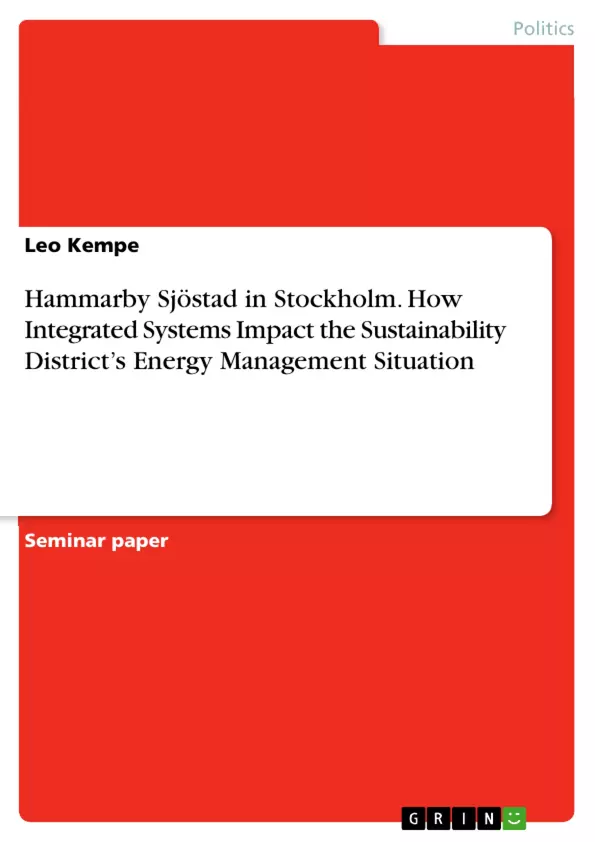This paper is an analytical description of Hammarby Sjöstad, a district in the Swedish capital of Stockholm that has been organized and planned around the objective of sustainability. This concerns elements such as wastewater treatment, urban hydrology, sustainable housing, and clean energy. The Stockholm City Planning Department has aimed to reduce the district's and overall city's carbon footprint as well as to prioritize initiatives for a sustainable urban life. In the analysis, the paper describes the so-called Hammarby Model with all its components and illustrates its contributions to a balanced and healthy life in Stockholm.
For Sweden, sustainability practices have long been a core part of national philosophy. By continuously working on solutions to different sectoral problems in trade, building, forestry and fishing, people’s well-being can be improved substantially. Communities in rural areas face the challenges of aggressive mining and climate change. However, also cities, like the capital Stockholm, must deal with multifaceted issues, from waste management, providing public transportation and green space accessibility to household and company energy consumption. Stockholm, the European Green Capital of 2010, has incorporated sustainability and circular thinking in its planning and decision-making practices. This becomes visible in the suburb of Hammarby Sjöstad. To better manage sustainability demands, the city administration created numerous political and strategic programs to focus on environmental concerns. The most significant one is the so-called 'Hammarby Model,' whose process and effects are analyzed in this paper. Supported by goals and guidelines, it is a circular model aiming at maximum recycling and reuse capacities. It was put in place to manage different sectors in the city and make them more efficient. The implementation of the model together with the sustainability guidelines and goals decreased resource consumption levels and increased efficient usage methods in most targeted sectors in Hammarby. However, in some other sectors, goals have proven not to be achievable because of limited capacities or operational discrepancies. Still, Hammarby Sjöstad can be regarded as exemplary and successful urban sustainability practice.
Inhaltsverzeichnis (Table of Contents)
- 1. Introduction: The idea of Hammarby Sjöstad
- 2. Methodology: Assessing Policy Effects
- 2.1. Research Design
- 2.2. Terminology and Concepts: Planning a Sustainable Development
- 2.3. Theoretical Argument
- 2.4. Hunches
- 3. Empirical Case: Procedural Development, Circular Management
- 3.1. Research Method
- 3.2. Operationalization and Materials
- 3.3. Closed-Loop Systems and Energy: The Hammarby Model
- 3.3.1. Elements
- 3.3.2. Goals
- 3.4. Effects on the Energy Situation: Achievements and Flaws
- 4. Conclusion and Outlook
Zielsetzung und Themenschwerpunkte (Objectives and Key Themes)
This paper analyzes the process of making Hammarby Sjöstad a sustainable district in Stockholm. The study aims to understand how the city's environmental policies and guidelines, particularly the 'Hammarby Model,' have shaped the district's energy situation. The paper investigates the conceptualization of the model, its implementation, and its impact on energy consumption and resource management.
- The development and implementation of the 'Hammarby Model' as a circular management system in Hammarby Sjöstad.
- The influence of sustainability policies on the district's energy situation.
- The effectiveness of the model in achieving its goals of resource efficiency and waste reduction.
- The challenges and limitations faced in implementing the model, particularly regarding achieving specific energy efficiency targets.
- The potential of Hammarby Sjöstad as an exemplary urban sustainability practice.
Zusammenfassung der Kapitel (Chapter Summaries)
Chapter 1 introduces the concept of Hammarby Sjöstad as a brownfield urban development project in Stockholm. It discusses the historical context of the area, its transformation from an industrial site to a sustainable district, and the motivations behind the development project. The chapter highlights the city's ambition to address environmental issues, particularly related to resource consumption and energy management.
Chapter 2 explores the methodological framework for assessing the policy effects of the Hammarby Model. It defines key terms and concepts related to sustainable development and outlines the research design, theoretical argument, and specific hypotheses guiding the study.
Chapter 3 delves into the empirical case study of Hammarby Sjöstad. It describes the research method used to analyze the district's development and presents data and observations related to the operationalization of the 'Hammarby Model.' This chapter further examines the model's components, its goals, and the overall impact of the model on the district's energy situation. It analyzes both the achievements and the limitations of the model in terms of its sustainability objectives.
Schlüsselwörter (Keywords)
The key terms and concepts central to this paper include: urban sustainability, Hammarby Sjöstad, circular economy, closed-loop systems, energy management, resource efficiency, waste reduction, sustainable development, environmental policies, and policy effects. The study focuses on the relationship between these concepts in the context of a specific urban development project and its impact on the energy situation of the district.
- Quote paper
- Leo Kempe (Author), 2022, Hammarby Sjöstad in Stockholm. How Integrated Systems Impact the Sustainability District’s Energy Management Situation, Munich, GRIN Verlag, https://www.grin.com/document/1437154



